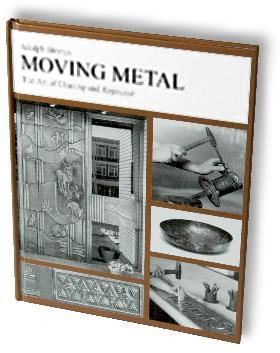|
|
|

|
Adolpf Steines
Moving Metal
The Art of Chasing and Repoussé
131 Pages, Hardbound, B&W illustrations size 8" x 10", 107 photographs 111 detailed drawings
|
Book Review by Jock Dempsey
Translated from the German it is flawless English. Steines clearly defines the differences between processes of repousse' and chasing.
There is none, other than, repousse' is done from the back and the other, chasing is done from the front.
Most detailed pieces are both, the working being done from both sides.

Repousse Samples
The book starts with a brief history of repousse' with photos of vessels, suits of armour and sculpture.
There is a brief discussion of materials and shop space then goes on to tools which is probably the most important part of the book.
While some commercial repousse' tools are available an artist needs every size and often custom shapes.

A complete set of repousse' punches can ranges from 40 or more pieces.
Throughout the book tool details are illustrated and their fine features become more apparent.
With careful study, a bench grinder, files and sand paper any craftsperson should be able to make their own repousse' tools or convert common punches and chisels to the task.

Lettering techniques working on carpet.
Work surfaces including carpet and lead are discussed.
Carpet is very handy (and safer than lead) and samples can be obtained free from carpet shops.
The best is tight (dense) smooth and relatively short.
Samples are usually 18" x 24" and are often edged.

Basic repousse' and chasing methods.
This is a very enlightening book that covers all the bases.
It is sufficient to learn what is needed to setup shop, make tools and teach oneself the art of repousse'.
Published by: Blue Moon Press
Huntingdon Pennsylvania
USA
Published: 1995 Charles Coleman Verlag GmbH & Co.
Reprinted: 2001 Blue Moon Press
ISBN 0-9707644-9-1
$35.00 US
Available from anvilfire.com advertisers.
Links:
|
|
|
Moving Metal
The Art of Chasing and Repoussé
131 Pages, Hardbound, B&W illustrations size 8" x 10", 107 photographs 111 detailed drawings
Book Review by Jock Dempsey
Translated from the German it is flawless English. Steines clearly defines the differences between processes of repousse' and chasing. There is none, other than, repousse' is done from the back and the other, chasing is done from the front. Most detailed pieces are both, the working being done from both sides.Repousse Samples
The book starts with a brief history of repousse' with photos of vessels, suits of armour and sculpture. There is a brief discussion of materials and shop space then goes on to tools which is probably the most important part of the book. While some commercial repousse' tools are available an artist needs every size and often custom shapes.
A complete set of repousse' punches can ranges from 40 or more pieces.
Throughout the book tool details are illustrated and their fine features become more apparent. With careful study, a bench grinder, files and sand paper any craftsperson should be able to make their own repousse' tools or convert common punches and chisels to the task.
Lettering techniques working on carpet.
Work surfaces including carpet and lead are discussed. Carpet is very handy (and safer than lead) and samples can be obtained free from carpet shops. The best is tight (dense) smooth and relatively short. Samples are usually 18" x 24" and are often edged.
Basic repousse' and chasing methods.
This is a very enlightening book that covers all the bases. It is sufficient to learn what is needed to setup shop, make tools and teach oneself the art of repousse'.
Published by: Blue Moon Press
Huntingdon Pennsylvania
USA
Reprinted: 2001 Blue Moon Press
ISBN 0-9707644-9-1
$35.00 US
Available from anvilfire.com advertisers.
Links: